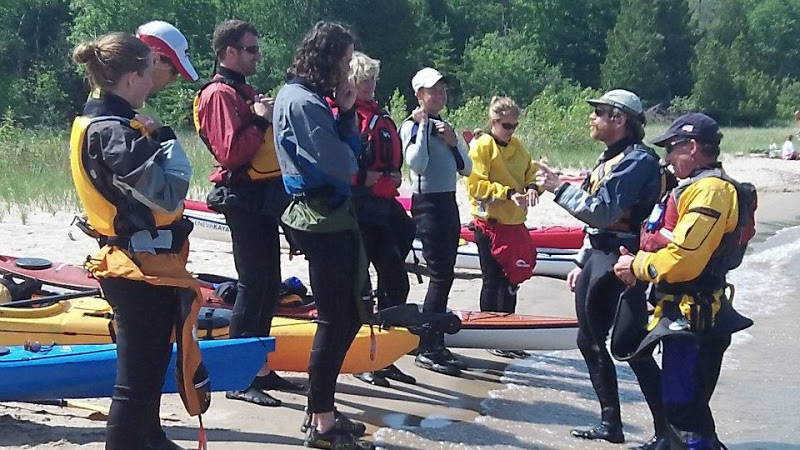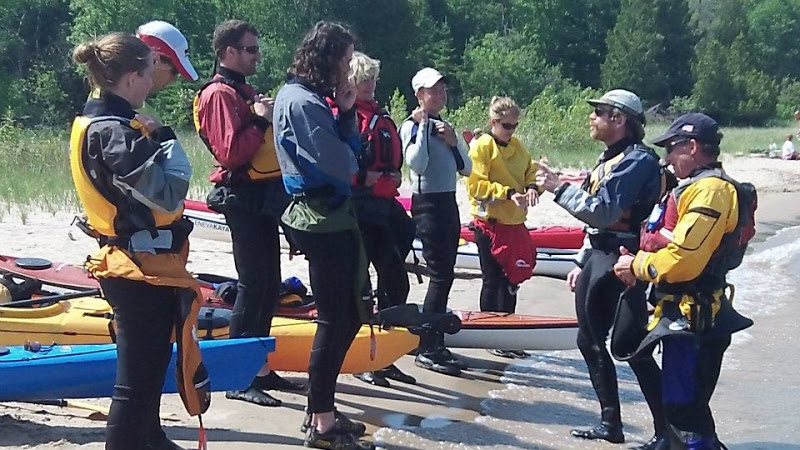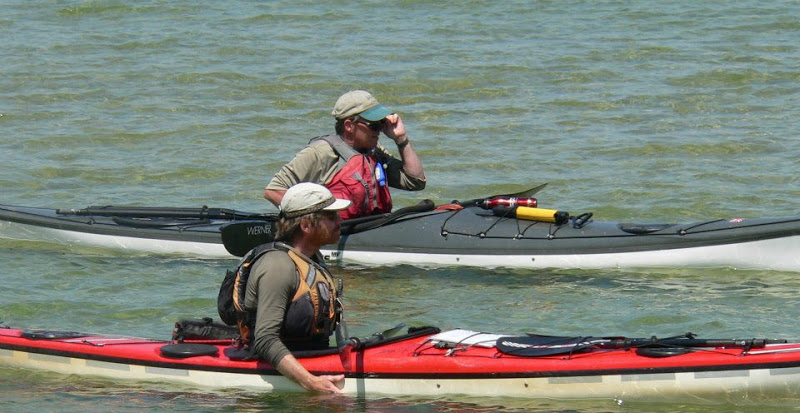By Mary Fairchild
Marquette’s ACA L5 trainer Sam Crowley.
Here you will brush up on skills you should already know.
“Mary, do you think you can do an expedition solo?” was the question. “No, I know I’m not ready yet. Don’t ask me to lead a group yet either,” I kept repeating when it came time to committing to the next level 4 expedition which always included having me lead one of the days. It seemed everytime I began to gain confidence in my seamanship I’d then wait too long before I’d reinforce it and, well, … I’d forget.
When I saw the way the Instructor Development Workshop that was being offered by Sam Crowley was worded it seemed to make sense for me to check it out this year, “Here you will brush up on skills you should already know.” “The IDW focuses on you obtaining coastal sea kayaking knowledge, experiencing various teaching techniques and modeling the paddling skills effectively. You will have a great opportunity for critique of your personal skills, learn new information and find out the specific areas you need work on for eventual completion of your instructor certification.” ACA Instructor Criteria
This was the year I decided I needed to start reviewing things and catching up on some things I may have missed. I bought a new PFD so I could fit all of my “responsible things” on it including my new marine radio but I’m still breaking out of the initial stress with all the gadgets and safety issues surrounding them. It had taken me about 5 times of totally taking my Hullivator off my car and back on before I finally could do it without question or looking back at instructions. My new VHF radio, which did not have the easiest instruction manual, if I didn’t use it again for a few weeks I could forget some of it’s functions, too.
Here’s Sam Crowley and Tim Pfleiger instructing as some nice waves begin to build at Portage Park in Door County. Our class was able to surf a few waves there later that day. Sam and Tim received their ACA training together in 1995 at nearby Rowley’s Bay. There are two components in the process to become an American Canoe Association certified Instructor: the Instructor Development Workshop (IDW – a three day event; the training) and the Instructor Certification Evaluation (ICE – a three day event; the testing).
Our group consisted of kayak guides, parks and recreation organizers, adventurers, and future ACA instructors. The ICE is designed to evaluate the instructor candidates regarding their skills as an instructor. Candidates are assessed on their teaching ability on and off the water which includes kayak skills as well as professionalism, attitude, personal equipment and physical fitness.
Recently, Connor had seen a video posted by Sam Crowley on how to do a self rescue if you lose your paddle and only have a half of your spare one to grab from your deck while capsized. Could you grab that half of your paddle and roll up? Connor could.
We all had topics to research and make 5-10 minute presentations on. Tina, from Marquette, and I had related presentations on waves and surf and I asked her, since she likes to surf(surf board) Lake Superior in Marquette, what her favorite surf was and she answered with, “Usually 8′ because anything bigger and you get really trashed.” She had an interesting perspective on ripe tides and how to purposefully find them and use them safely as well.
My topic was “waves in deep water.” I used one of Sam’s well-used maps (Apostle Islands) to discuss how I had learned to favor a couple of islands on that map. The longer the wind blows and the larger the distance of open water(fetch) upwind, the bigger the waves become.
Carly, from West Bend, led us in morning yoga stretching, something she likes to do. Sam had organized activites that had us remembering our names, loosening up before we were tested on skills, and checking out our endurance like chariot paddling to shore after on-water practice. The whole weekend was organzed very well. Everyone had received a schedule in the mail the week before the class so we could prepare and know what would be expected of us.
We were all video taped, even Sam as he demonstrated what we needed to do. I got to see my roll on video for the first time. I always wondered how my head looked. I’m looking forward to practicing in some shallow areas now, too. I want to work on my balance and sculling more and I don’t know why I had never thought about doing it in shallow water… An intermediate paddler’s rolls are successful 50% of the time and they can perform a re-enter and roll with a paddle float (Sea Kayaker Magazine’s Handbook of Safety and Rescue, p.182). Check.
The weekend after my IDW I met Sue Gjerset, from Minnesota, at Northport Pier. We eventually met up with a group of paddlers at Rock Island State Park for the weekend. This year we both looked forward to getting more independent in our seamanship skills. Sue and I are planning to take some private training with Sam Crowley together and we are also looking into his Adaptive Paddling Workshops.
Northport exists solely to accommodate a ferry line to Washington Island. The pier was established as an escape from fierce prevailing winds on the Gills Rock side. The legendary Death’s Door is located here at Gills Rock between the mainland and Washington Island. Death’s Door is where both Door County and Door Peninsula got their names.
“So, what do you think Mary? We will be committed to our paddle back on Sunday if we launch from here without a ferry ticket,” Sue reminded me as I rechecked the latest weather report. Storms brew up there quickly and there was a 70 % chance of thunderstorms on Sunday at that time. The area was dry and they needed the storms and it seemed like they were due. We reconsidered our options at least three times but always came down to not taking the risk.
Although “scattered,” 70% and the word “thunder” could not be taken lightly at this time and as we boarded the ferry we had already shifted from disappointment to some of the options we had for that day now that we were not making the trip from the mainland. First thing off the ferry, I have Sue do a u-turn back to the kayak and bike rentals. “Let’s ask the locals what we should see so we don’t miss something,” I explained after getting Sue to park with me for a quick stop. After a brief chat it appeared that we ought not miss Schoolhouse Beach so we winded our way through Washington Island and decided the picnic area would be a good place for lunch after a short exploratory paddle to get our feet wet.
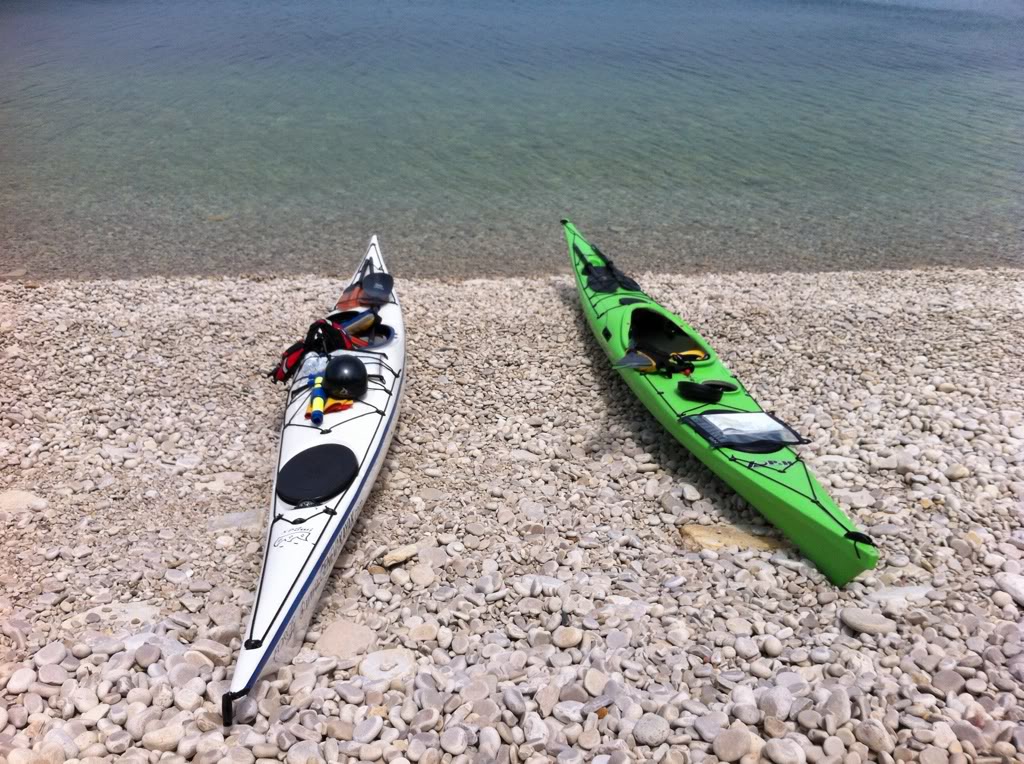
Schoolhouse Beach, Washington Island.
As we got our gear ready to launch we were so taken by the beauty there. There was no sand only beautiful white smooth stones and crystal clear water in beautiful shades of blue like the Caribbean. You cannot see this from a distance, you need to be right on it is the thing. Had we just paddled by circumnavigating the island I don’t know if we’d have thought to pull in the bay.
Winds were whipping up whitecaps and we felt our boats were being totally surfed in one huge glide out of the bay and we looked at each other and noted we’d need to allow some extra time to head into that to make our way back to our picnic site. I remember just ruddering and steering my whole way out and around the bend. Fun.
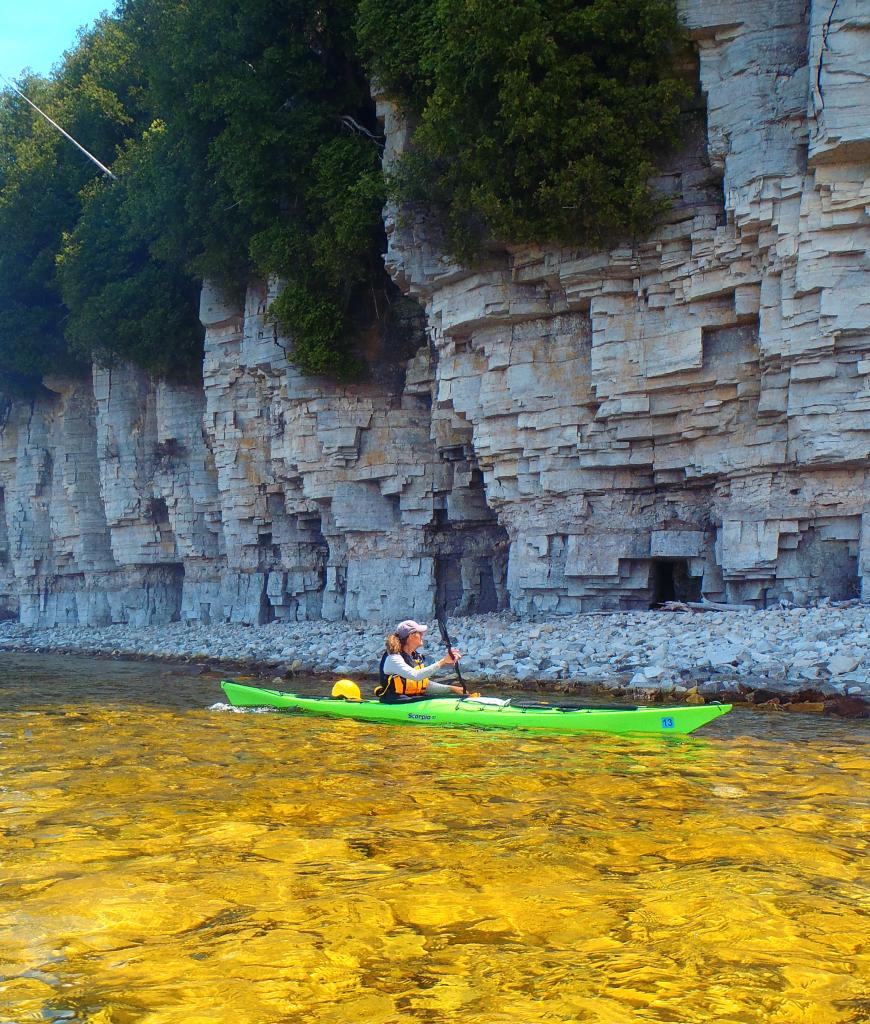 Washington Island, NW corner. Niagra Escarpment.
Washington Island, NW corner. Niagra Escarpment.
Beyond Washington Island is one of the Niagara Escarpment’s longest gaps (a cliff-like ridge of rock) as it stretches under the waters to Michigan and on to Ontario. The escarpment is a mere 160′ above the lake’s surface, surrounding Washington Island’s wave-battered exterior.
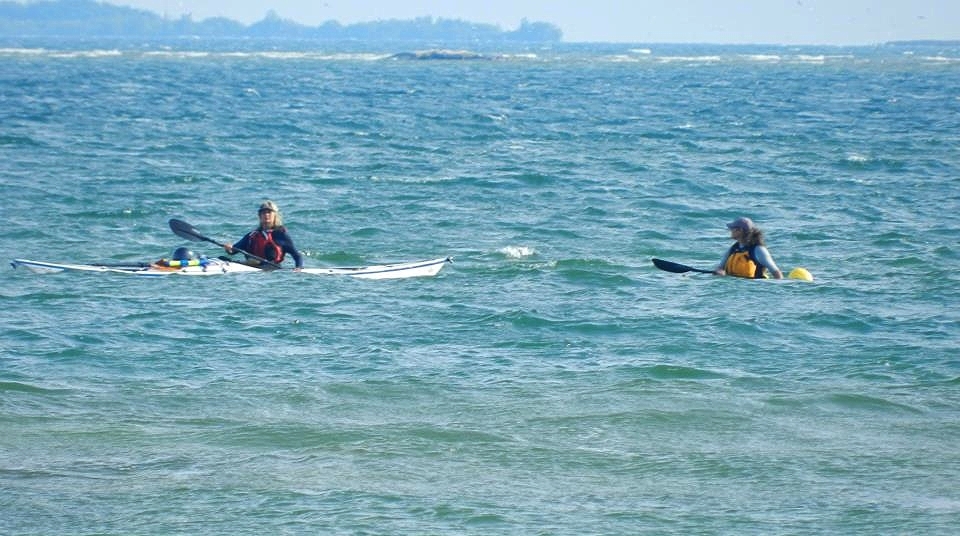 That’s Sue and me preparing to land on Rock Island State Park. Sue’s checking out the surf behind us for later. Good girl. Photo courtesy of Ken Braband.
That’s Sue and me preparing to land on Rock Island State Park. Sue’s checking out the surf behind us for later. Good girl. Photo courtesy of Ken Braband.
Paddling in a loaded kayak was not new for Sue and I. We met two years ago on a 9-day expedition that circumnavigated Isle Royale with Ryan Rushton of Geneva Kayak. We’ve both progressed past having to be towed in conditions with Ryan’s trips. Ryan was a good sport with us, and he actually let me “tow him” at the end of that Isle Royale trip when I joked about it. Sue and I have had rough water rescue practice in the ocean and in the whitewater current and if I were to sum us up as a team I’d say Sue is the advancing athlete and I’m the one who unconsciously has good balance and takes advantage of it to have a lot of fun. We were in great company with Ken and Mary Braband, their daughter Jacey, Steve Landers and his girlfriend, Kris for our Rock Island trip.
Kris, Steve, Sue, Mary and Ken Braband gearing up for Saturday’s paddle. Rock Island State Park.
If you look closely you will see some of our tents on the bluff behind everyone in the picture above. The wind was mostly out of the south and west and we had waves crashing in on the shoals that sounded, looked, and felt like camping by the ocean.
 Sue double-checking my bearings that were plotted for our paddle from Rock Island to the mainland.
Sue double-checking my bearings that were plotted for our paddle from Rock Island to the mainland.
It’s always good to double-check your plans. I found Sam Crowley’s blog very interesting when he reported mapping out a route to the wrong island one day. I thought those things only would happen to me. Sam has some nice surf stories from Marquette on his blog as well: April 2010.
This past March Sue and I went on a trip with Geneva Kayak that circumnavigated Cumberland Island for our second time. It was a great place to work on navigation in tides and current and catch some nice surf as well.
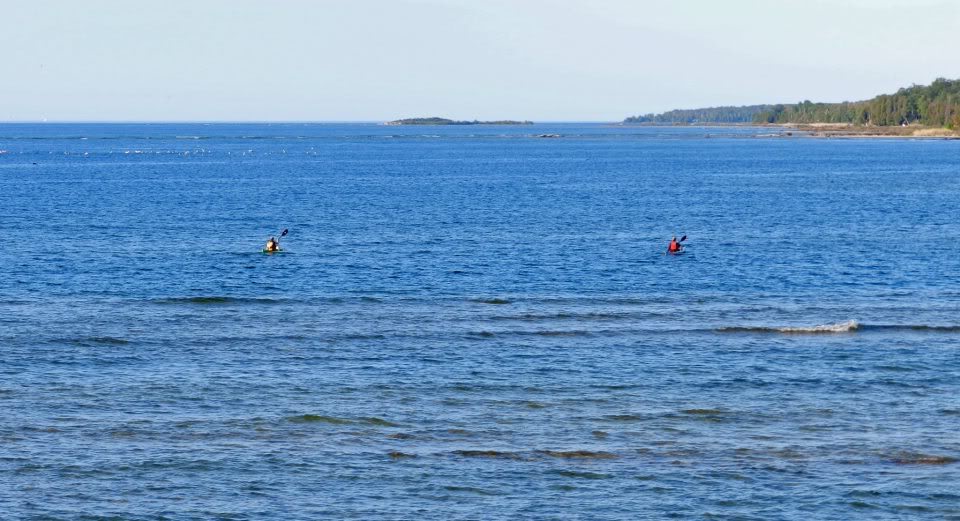 Sue and I heading out on our last day from Rock Island to Northport Pier! Picture courtesy of Ken Braband.
Sue and I heading out on our last day from Rock Island to Northport Pier! Picture courtesy of Ken Braband.
Sunday turned out to be a good day after all–thanks to Ken, Mary, and Jacey who drove our cars onto the ferry so Sue and I could paddle back to the mainland. We did have wind and it had been windy the day and night before. On our perfectly sunny morning we safely paddled in 2′ surf and swell with some whitecaps and some spray. Loved it.
- Sea Change and Sea Kayaking (Door County; Dolostone; Niagara Escarpment; Mazon Creek)
- Adaptive Paddling: Drawing a Line in the Sand (Apostle Islands; Big Bay, MI)

